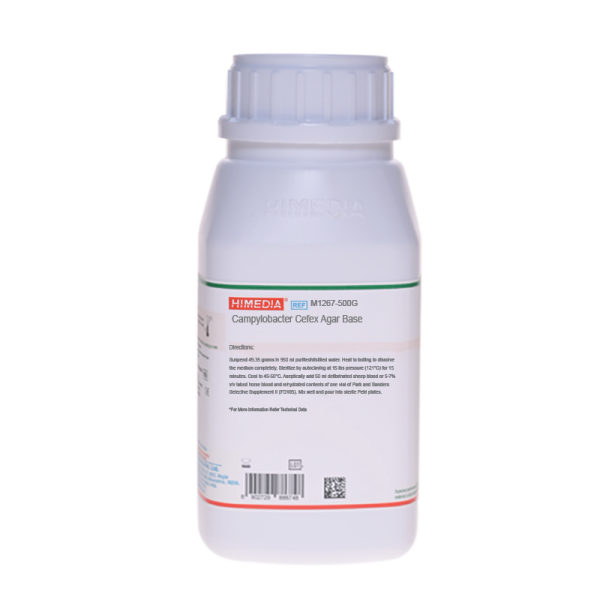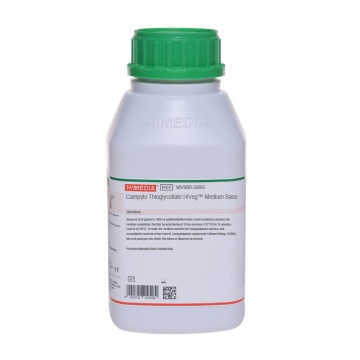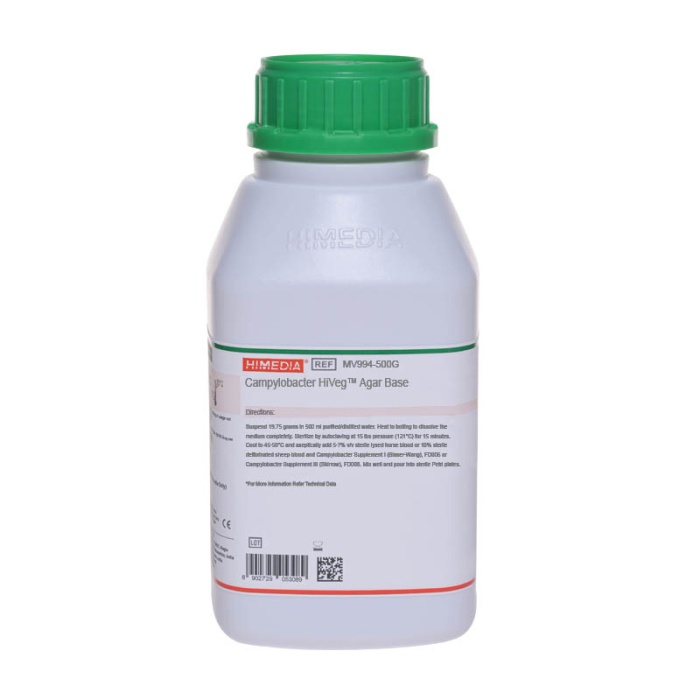 Your enquiry has been submitted
Your enquiry has been submitted
Campylobacter Cefex Agar Base
Intended Use
Recommended for isolation and cultivation of Campylobacter species.
Composition
| Ingredients | g/L |
|---|---|
| Tryptone | 15.000 |
| Peptone | 10.000 |
| Sodium chloride | 5.000 |
| Yeast extract | 2.000 |
| Dextrose (Glucose) | 1.000 |
| Ferrous sulphate | 0.500 |
| Sodium pyruvate | 0.500 |
| Sodium bisulphite | 0.350 |
| Agar | 15.000 |
Final pH (at 25°C): 7.0±0.2
Formula adjusted, standardized to suit performance parameters
Directions
Suspend 49.35 grams in 950 ml purified / distilled water. Heat to boiling to dissolve the medium completely. Sterilize by autoclaving at 15 lbs pressure (121°C) for 15 minutes. Cool to 45-50°C. Aseptically add 10% defibrinated sheep blood or 5-7% v/v laked horse blood and rehydrated contents of one vial of Park and Sanders Selective Supplement II, (FD105). Mix well and pour into sterile Petri plates.
Principle And Interpretation
Campylobacter species were associated with variety of veterinary diseases and also has been characterized as bacterial agents of human foodborne gastroenteritis. The organisms may also be transmitted by contaminated food or water. Campylobacter Cefex Agar Base is used for isolation and cultivation of Campylobacter species (1). Campylobacter Agar with antimicrobics and 50 ml sheep blood is recommended as a selective medium for the primary isolation and cultivation of Campylobacter species. Campylobacter Cefex Agar Base is a highly nutritious base and the addition of horse blood supplements the medium with X-factor and other growth factor requirements. Tryptone, Peptone and yeast extract provide nitrogenous compounds, carbon, sulphur, vitamins and trace ingredients. Glucose is utilized as an energy source. Sheep blood supplies the X-factor (heme) and other growth requirements. Incorporation of antibiotics (FD105) suppresses the growth of the normal microbial flora in the specimens thereby facilitating isolation of Campylobacter species. The addition of antimicrobials to the medium is required to suppress the growth of normal flora. Cefoperazone is added to inhibit many gram-positive and gram-negative organisms (Aerobic and anaerobic). Cycloheximide is added to inhibit the growth of contaminating fungi. Campylobacter Cefex Agar Base can be used for direct inoculation or indirect inoculation. After inoculation, incubate the plates at 42°C for 48-72 hours in microaerophilic atmosphere. In addition, media may be set up in duplicate with the second set incubated at 35-37°C to allow for the growth of certain Campylobacter species. Campylobacter jejuni colony morphology may appear as small mucoid, grayish flat colonies with irregular edges and no hemolytic patterns after 24-48 hours. Colonies may also appear pink or yellowish gray with some colonies exhibiting a tailing effect along the streak line (2). They may also appear as round, convex, entire, glistening, 1-2 mm in diameter.
Cephalothin-sensitive Campylobacter species such as C.fetus and C.upsaliensis may not be recovered on Campylobacter Cefex Agar Base because it contains cefoperazone (3). These agents in selective media may inhibit some strains of desired species. Therefore, specimens cultured on selective media should also be cultured on non-selective media to obtain additional information and to ensure recovery of potential pathogens.
Type of specimen
Clinical samples - faeces; Food and dairy samples; Water samples
Specimen Collection and Handling
For clinical samples follow appropriate techniques for handling specimens as per established guidelines (4,5).
For food and dairy samples, follow appropriate techniques for sample collection and processing as per guidelines (6,7,8).
For water samples, follow appropriate techniques for sample collection, processing as per guidelines and local standards.(9)
After use, contaminated materials must be sterilized by autoclaving before discarding.
Warning and Precautions
In Vitro diagnostic Use. For professional use only. Read the label before opening the container. Wear protective gloves/protective clothing/eye protection/ face protection. Follow good microbiological lab practices while handling specimens and culture. Standard precautions as per established guidelines should be followed while handling clinical specimens. Safety guidelines may be referred in individual safety data sheets.
Limitations
- Some agents in selective media may inhibit some strains of desired species.
- Furthermore, specimens cultured on selective media should also be cultured on non-selective media to obtain additional information and to fortify recovery of potential pathogens.
Performance and Evaluation
Performance of the medium is expected when used as per the direction on the label within the expiry period when stored at recommended temperature.
Quality Control
Appearance: Cream to yellow homogeneous free flowing powder
Gelling: Firm, comparable with 1.5% Agar gel
Colour and Clarity of prepared medium: Basal medium: Yellow coloured clear to slightly opalescent gel. After addition of blood: Cherry red coloured opaque gel forms in Petri plates
Reaction: Reaction of 4.94% w/v aqueous solution at 25°C. pH: 7.0±0.2
pH: 6.80-7.20
Cultural Response
Cultural characteristics observed under microaerobic atmosphere with added 10%v/v defibrinated sheep blood or 5-7%v/v laked horse blood and Park and Sanders Selective Supplement II, (FD105), after an incubation at 35-37°C for 18-24 hours.
| Organism | Inoculum (CFU) | Growth | Recovery |
|---|---|---|---|
| Campylobacter jejuni ATCC 29428 (00156*) | 50-100 | good-luxuriant | >=50% |
| Escherichia coli ATCC 25922 (00013*) | 50-100 | none-poor | <=10% |
| Enterococcus faecalis ATCC 29212(00087*) | 50-100 | none-poor | <=10% |
Key: *Corresponding WDCM numbers.
Storage and Shelf Life
Store between 10-30°C in a tightly closed container and the prepared medium at 2-8°C. Use before expiry date on the label. On opening, product should be properly stored dry, after tightly capping the bottle in order to prevent lump formation due to the hygroscopic nature of the product. Improper storage of the product may lead to lump formation. Store in dry ventilated area protected from extremes of temperature and sources of ignition Seal the container tightly after use. Product performance is best if used within stated expiry period.
Disposal
User must ensure safe disposal by autoclaving and/or incineration of used or unusable preparations of this product. Follow established laboratory procedures in disposing of infectious materials and material that comes into contact with clinical sample must be decontaminated and disposed of in accordance with current laboratory techniques (4,5).
References
- Atlas R. M., 1993, Handbook of Microbiological Media, Parks L.C. (Ed.), CRC press, Boca Raton
- Forbes B. A. et al, 2002, Bailey and Scotts Diagnostic Microbiology, 11th Ed., Mosby Company, St. Louis, MO.
- Murray P. R., Baron J. H., Pfaller M. A., Jorgensen J. H. and Yolken R. H., (Ed.), 2003, Manual of Clinical Microbiology, 8th Ed., American Society for Microbiology, Washington, D.C.
- Isenberg, H.D. Clinical Microbiology Procedures Handbook 2nd Edition.
- Jorgensen, J.H., Pfaller, M.A., Carroll, K.C., Funke, G., Landry, M.L., Richter, S.S and Warnock., D.W. (2015) Manual of Clinical Microbiology, 11th Edition. Vol. 1.
- American Public Health Association, Standard Methods for the Examination of Dairy Products, 1978, 14th Ed., Washington D.C.
- Salfinger Y., and Tortorello M.L., 2015, Compendium of Methods for the Microbiological Examination of Foods, 5th Ed., American Public Health Association, Washington, D.C.
- Wehr H. M. and Frank J. H., 2004, Standard Methods for the Microbiological Examination of Dairy Products, 17th Ed., APHA Inc., Washington, D.C.
- Baird R.B., Eaton A.D., and Rice E.W., (Eds.), 2015, Standard Methods for the Examination of Water and Wastewater, 23rd ed., APHA, Washington, D.C.
| Product Name | Campylobacter Cefex Agar Base |
|---|---|
| SKU | M1267 |
| Product Type | Regular |
| Physical Form | Powder |
| Origin | Animal |
| Packaging type | HDPE |
| References | 1. American Public Health Association, Standard Methods for the Examination of Dairy Products, 1978, 14th Ed.,Washington D.C. |
| Customized Product Available | No |











